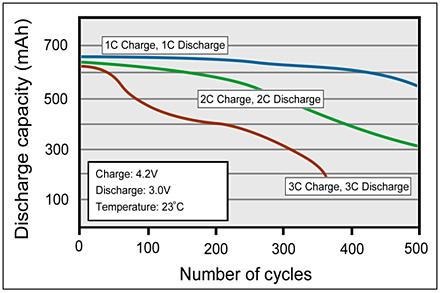Tässä on aiheesta yksi suomalainen tutkimus:
...Consequently, users are increasingly relying on a number of Fast charging techniques from Qualcomm (Quick [9]) and Samsung (Fast). Nevertheless, the quality of charging plays an important role in the longevity of smartphone batteries. For example, if a battery is charged over the maximum battery voltage, the resulting chemical reactions may reduce the capacity significantly [2] and increase the battery temperature beyond the safety limit...
...Among 30K, only 3% of the devices use Quick and Fast charging...
...By examining the charging events, we have identified that 1% of the devices use charging rates higher than 1C. These are the Fast charging enabled devices...
...We have also identified two kinds of Fast charging technique. Their charging rates vary within 0.7-1.1C...
...We notice that Fast charging increases battery temperature by 8-10◦C than that of the DLC model devices...
...A small number of devices had a charging current higher than 1.0C, which also degrades battery performance quickly...
Tuossa ei suoraan sanota, kuinka paljon pikalataus heikentää akun käyttöikää verrattuna normaaliin lataukseen. Tutkimuksessa kuitenkin todetaan, että yli 1C:n lataus heikentää akun suorituskykyä nopeasti. 1C:n lataus tarkoittaa 3000mAh akulla 3A:n latausvirtaa. Tutkimuksessa mukana olleet pikalataustekniikat (Qualcomm Quick Charge 2.0 ja Samsung Adaptive Fast Charge) latasivat 0.7-1.1C arvoilla. QC 3.0 lataa
Qualcommin mukaan 2750mAh:n akkua korkeintaan 1.5C:n arvolla. Esimerkiksi
BatteryUniversity ohjeistaa lataamaan alle 1C:n arvolla.
Apply the ultra-fast charge only when necessary. A well-designed ultra-fast charger should have charge-time selection to give the user the option to choose the least stressful charge for the time allotted. Figure 2 compares the cycle life of a typical lithium-ion battery when charged and discharged at 1C, 2C and 3C rates. The longevity can further be prolonged by charging and discharging below 1C; 0.8C is the recommended rate.
XDA:n testissä poimittuna laitteet latasivat seuraavasti:
- OnePlus 3 (3000mAh): 1.33C (Dash Charge)
- Mate 9 (4000mAh): 1.25C (SuperCharge)
- Galaxy S8+ (3500mAh): 0.86C (Adaptive Fast Charging)
- Pixel XL (3450mAh): 0.71C (USB Power Delivery)
Sitä en sitten osaa mennä sanomaan, kuinka paljon noilla on loppujen lopuksi eroa käytännön elämässä.

 ! Aika hurjalta tuntuu tuohon tahtiin lataaminen. Luulin jo, että Mate X:n 55W lataus olisi kova sana. Meneeköhän kuitenkin ensi vuoteen, että näitä tulee markkinoille?
! Aika hurjalta tuntuu tuohon tahtiin lataaminen. Luulin jo, että Mate X:n 55W lataus olisi kova sana. Meneeköhän kuitenkin ensi vuoteen, että näitä tulee markkinoille?